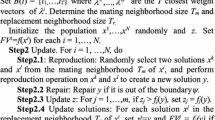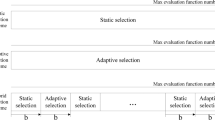Abstract
Evolutionary algorithms (EAs) are population-based search and optimization methods whose efficacy strongly depends on a fine balance between exploitation caused mainly by its selection operators and exploration introduced mainly by its variation (crossover and mutation) operators. An attempt to improve an EA’s performance by simply adding a new and apparently promising operator may turn counter-productive, as it may trigger an imbalance between the exploitation-exploration trade-off. This necessitates a proper understanding of mechanisms to restore the balance while accommodating a new operator. In this paper, we introduce a new repair operator based on an AI-based mapping between past and current good population members to improve an EA’s convergence properties. This operator is applied to problems with different characteristics, including single-objective (with single and multiple global optima) and multi-objective problems. The focus in this paper is to highlight the importance of restoring the exploitation-exploration balance, when a new operator is introduced. We show how different combinations of problems and EA characteristics pose different opportunities for restoration of this balance, enabling the repair-based EAs/EMOs to outperform the original EAs/EMOs in most cases.
This research work has been supported by Government of India under SPARC project P66.
Access this chapter
Tax calculation will be finalised at checkout
Purchases are for personal use only
Similar content being viewed by others
Notes
- 1.
The parameters are taken from https://keras.io/api/optimizers/adam/.
References
Battiti, R., Brunato, M.: Reactive search optimization: learning while optimizing. In: Gendreau, M., Potvin, J.Y. (eds.) Handbook of Metaheuristics. ISOR, vol. 146, pp. 543–571. Springer, Boston (2010). https://doi.org/10.1007/978-1-4419-1665-5_18
Das, I., Dennis, J.: Normal-boundary intersection: a new method for generating the pareto surface in nonlinear multicriteria optimization problems. SIAM J. Optim. 8(3), 631–657 (1998)
Deb, K., Jain, H.: An evolutionary many-objective optimization algorithm using reference-point based non-dominated sorting approach, part I: solving problems with box constraints. IEEE Trans. Evol. Comput. 18(4), 577–601 (2014)
Deb, K., Saha, A.: Multimodal optimization using a bi-objective evolutionary algorithms. Evol. Comput. J. 20(1), 27–62 (2012)
Deb, K., Srinivasan, A.: Innovization: innovating design principles through optimization. In: Proceedings of the Genetic and Evolutionary Computation Conference (GECCO-2006), pp. 1629–1636. ACM, New York (2006)
Finck, S., Hansen, N., Ros, R., Auger, A.: Real-parameter black-box optimization benchmarking 2010: presentation of the noiseless functions. Technical report 2009/20, Research Center PPE (2010)
Gaur, A., Deb, K.: Effect of size and order of variables in rules for multi-objective repair-based innovization procedure. In: Proceedings of Congress on Evolutionary Computation (CEC-2017) Conference. IEEE Press, Piscatway (2017)
Ghosh, A., Goodman, E., Deb, K., Averill, R., Diaz, A.: A large-scale bi-objective optimization of solid rocket motors using innovization. In: 2020 IEEE Congress on Evolutionary Computation (CEC), pp. 1–8 (2020)
Goldberg, D.E., Deb, K.: A comparison of selection schemes used in genetic algorithms. In: Foundations of Genetic Algorithms 1 (FOGA-1), pp. 69–93 (1991)
Goldberg, D.E., Richardson, J.: Genetic algorithms with sharing for multimodal function optimization. In: Proceedings of the First International Conference on Genetic Algorithms and Their Applications, pp. 41–49 (1987)
Huband, S., Hingston, P., Barone, L., While, L.: A review of multiobjective test problems and a scalable test problem toolkit. IEEE Trans. Evol. Comput. 10(5), 477–506 (2006)
Kennedy, J., Eberhart, R.: Particle swarm optimization. In: Proceedings of IEEE International Conference on Neural Networks, pp. 1942–1948. IEEE Press (1995)
Mittal, S., Saxena, D.K., Deb, K.: Learning-based multi-objective optimization through ANN-assisted online innovization. In: Proceedings of the 2020 Genetic and Evolutionary Computation Conference Companion, GECCO 2020, pp. 171–172. Association for Computing Machinery, New York (2020)
Mittal, S., Saxena, D.K., Deb, K., Goodman, E.: An ANN-assisted repair operator for evolutionary multiobjective optimization. Technical report COIN report no. 2020005, Michigan State University, East Lansing, USA (2020). https://www.egr.msu.edu/~kdeb/papers/c2020005.pdf
Mittal, S., Saxena, D.K., Deb, K., Goodman, E.: Enhanced innovized repair operator for evolutionary multi- and many-objective optimization. Technical report COIN report no. 2020020, Michigan State University, East Lansing, USA (2020). https://www.egr.msu.edu/~kdeb/papers/c2020020.pdf
Padhye, N., Deb, K., Mittal, P.: Boundary handling approaches in particle swarm optimization. In: Bansal, J., Singh, P., Deep, K., Pant, M., Nagar, A. (eds.) BIC-TA 2012. AISC, vol. 201, pp. 287–298. Springer, Cham (2013). https://doi.org/10.1007/978-81-322-1038-2_25
Pétrowski, A.: A clearing procedure as a niching method for genetic algorithms. In: IEEE 3rd International Conference on Evolutionary Computation (ICEC 1996), pp. 798–803 (1996)
Wierzbicki, A.P.: The use of reference objectives in multiobjective optimization. In: Fandel, G., Gal, T. (eds.) Multiple Criteria Decision Making Theory and Applications. LNE, vol. 177, pp. 468–486. Springer, Heidelberg (1980). https://doi.org/10.1007/978-3-642-48782-8_32
Zitzler, E., Deb, K., Thiele, L.: Comparison of multiobjective evolutionary algorithms: empirical results. Evol. Comput. 8(2), 173–195 (2000)
Author information
Authors and Affiliations
Corresponding author
Editor information
Editors and Affiliations
Rights and permissions
Copyright information
© 2021 Springer Nature Switzerland AG
About this paper
Cite this paper
Deb, K., Mittal, S., Saxena, D.K., Goodman, E.D. (2021). Embedding a Repair Operator in Evolutionary Single and Multi-objective Algorithms - An Exploitation-Exploration Perspective. In: Ishibuchi, H., et al. Evolutionary Multi-Criterion Optimization. EMO 2021. Lecture Notes in Computer Science(), vol 12654. Springer, Cham. https://doi.org/10.1007/978-3-030-72062-9_8
Download citation
DOI: https://doi.org/10.1007/978-3-030-72062-9_8
Published:
Publisher Name: Springer, Cham
Print ISBN: 978-3-030-72061-2
Online ISBN: 978-3-030-72062-9
eBook Packages: Computer ScienceComputer Science (R0)




